- Barrow Neurological Institute at Phoenix Children's
- Pediatric Intensive Care Unit (PICU) & Critical Care
- Rehabilitation Services
In April 2015, Carolyn and John welcomed their fourth child, Kate, into the world. Although Kate was born with the same medical condition as her siblings, salt-wasting disorder, an inherited condition where the body isn’t able to hold onto sodium or salt, she was otherwise perfect.
“We saw a nephrologist in the first week who put her on supplements and sodium in her bottle,” Carolyn says. “She was doing really well—ate the best out of all our kids.”
Left untreated, salt-wasting disease can lead to vomiting, dehydration and even death, but thanks to early diagnosis that’s done at birth, innovative treatment therapies and her parents’ awareness of the disease, most children like Kate and her siblings lead healthy, productive lives.
Strange symptoms
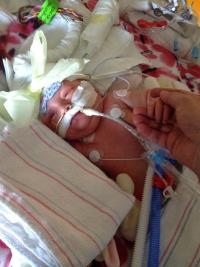
All seemed to be going well until 10 days later, when Kate’s health took a strange turn. Carolyn and John had trouble waking her for feedings, and when Kate did feed, it wasn’t much. The next day, they took her to the doctor with a fever—the reading said 103 degrees. Kate’s doctor wasted no time and sent them to the emergency department at Phoenix Children’s Hospital where the emergency team jumped into action working on Kate.
They ran several tests and diagnosed Kate with a severe case of HPIV-3, a human parainfluenza virus that causes inflammation in the smallest airways of the lungs. They placed Kate on oxygen, and while it helped her levels improve a bit, Kate’s health did not.
“Normally Kate looked pink, but she was totally white,” Carolyn recalls. “I ran out and told the nurse this isn’t how she normally looks and the next thing I know tons of people were in there working on Kate. It was all surreal.”
A respiratory therapist and team took Kate to Phoenix Children’s Pediatric Intensive Care Unit (PICU) where she was placed on a ventilator to help her breathe.
A race to save Kate’s life
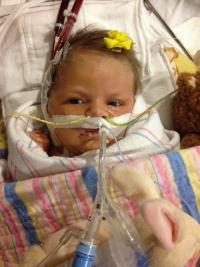
On day 18 of Kate’s life, when she was a little more than two weeks old, doctors determined Kate was so sick she would need to be placed on extracorporeal membrane oxygenation, or ECMO, an advanced life support technique, which can support heart and lung function while doctors treat patient’s underlying conditions. In Kate’s case, it was a life-or-death situation.

Placing a child on ECMO is a complex and difficult procedure, but her family knew Kate was in the best of hands. Phoenix Children’s ECMO program is the first pediatric and neonatal ECMO program in Arizona and the largest in the state. The program has been designated four times as a Gold “Center of Excellence by the international Extracorporeal Life Support Organization.
Dr. Jae-O Bae, a pediatric surgeon at Phoenix Children’s, performed the surgery to attach the ECMO to Kate’s tiny body. Kate was also placed on dialysis because her body was so swollen and given an EEG head cap to wear to track her brain activity. It was then that doctors shared more unfortunate news: Kate had a clot in the vein that goes from her forehead to the back of her skull. She had likely suffered a brain hemorrhage or stroke as well.
“[As we took in all this news], I just remember thinking that no matter what, no matter what cognitive behavioral challenges she had, we just wanted to be able to take Kate home someday,” Carolyn says. “We were prepared for her to be severely disabled.”
It takes a village
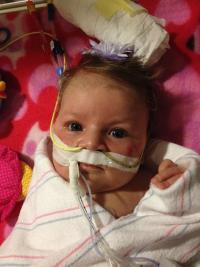
Carolyn and John met with a team of doctors to discuss next steps, such as how long Kate should be kept on ECMO, whether she would need a lung transplant and why she wasn’t improving. The team was still working to identify why Kate got sick so fast with HPIV-3, as the condition usually doesn’t progress like that.
“Having these conversations was hard as a parent, but I want to thank them for not giving up,” Carolyn says. “Because of them, and the quick thinking of one of the Phoenix Children’s pathologists, they were able to narrow the root cause for Kate’s medical issues.”
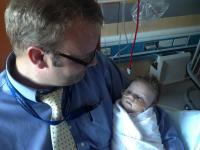
Kate was diagnosed with Legionnaire’s disease, a form of pneumonia caused by a bacteria found in water delivery systems that when inhaled can cause an infection in the lungs.
“We don’t know how she got Legionnaire’s disease, but as soon as the doctors knew what was causing the problems and went to work to treat our Kate, the sooner she started feeling better,” Carolyn says.
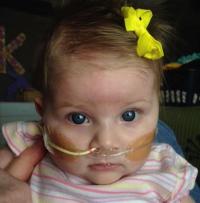
After 31 days on ECMO, Kate was healthy enough to go off ECMO. The next milestones were placing a nasogastric (NG) tube in her nose and down to her stomach to help her get liquid food and medicine. Then, Kate also started getting shots a couple times per day for her blood clot. Then after 62 days at Phoenix Children’s, her family got the best news: Kate was ready and well enough to go home.
A few months later, Kate had surgery to place a feeding tube – a soft, flexible tube inserted into the stomach wall to help people who have trouble eating or drinking typically. She also started occupational therapy, physical therapy and was enrolled in Phoenix Children’s Intensive Feeding Program as well.
Shortly after Kate’s first birthday, her mom remembers her starting to grow like a weed; eventually, she became the best eater of all her siblings.
Kate’s six and thriving

This fall, Kate will enter first grade. Although she has some minor fine motor troubles, Kate’s thriving. She loves all things cats, mermaids and unicorns. And if she’s not inside drawing, coloring or making up imaginative stories, you can find her outdoors running, jumping and playing. Kate also loves to dance and is currently enrolled in ballet class.
Kate is a busy, active girl – but the activity that brings the most joy to her mom is hiking.
“It often brings tears to my eyes seeing her do physical things like that, given what her lungs and little body went through when she was a baby,” Carolyn says. “Even just seeing her run around our backyard makes me teary-eyed.”
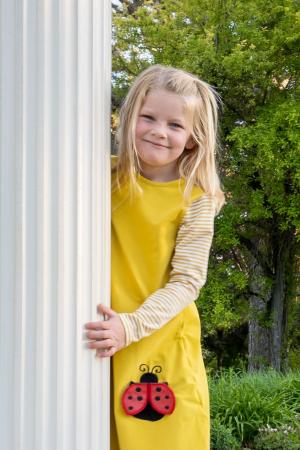
Kate’s special feeding tube is long gone; “she had that removed when she was 2,” Carolyn says. “And I’m happy to report her clot is completely gone.”
In the years since she left the hospital, Kate has also filled a special role in her family. Often acting more mature than a typical 6-year-old girl, she is known as the peacemaker among her siblings.
“All children are valuable to their parents and families. But Kate is such a stabilizing force and such a loving little girl that we truly can’t imagine life without her,” says her dad John. “This makes us all the more thankful for the army of doctors and nurses at Phoenix Children’s.”
While the family lives far from Phoenix Children’s – they moved to Utah a few years ago – the staff at the hospital are always close in their hearts and minds.
“We love Phoenix Children’s; I just wish we lived closer, so we could give [all the staff] a big hug,” Carolyn said. “Kate was too young to remember the experience, which is a good thing, but she grew fast, healed fast and today is just so resilient. The fact she’s doing so well and she’s alive is due to them.”

